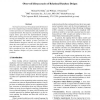Free Online Productivity Tools
i2Speak
i2Symbol
i2OCR
iTex2Img
iWeb2Print
iWeb2Shot
i2Type
iPdf2Split
iPdf2Merge
i2Bopomofo
i2Arabic
i2Style
i2Image
i2PDF
iLatex2Rtf
Sci2ools
WCRE
1995
IEEE
1995
IEEE
Observed Idiosyncracies of Relational Database Designs
Several processes have been advanced in the literature for reverse engineering of relational databases. The inputs to these processes are relational tables and available contextual information. The output is a model of the underlying logical intent, apart from the implementation artifacts. Most of the existing processes for database reverse engineering are inadequate; they assume too high a quality of input information. The authors of these processes are skilled database designers and they are overly optimistic about the state-of-the-art, as practiced. This paper catalogs odd aspects of relational database designs that we have encountered over the past several years. Many of these database designs are from commercial software products.
| Added | 26 Aug 2010 |
| Updated | 26 Aug 2010 |
| Type | Conference |
| Year | 1995 |
| Where | WCRE |
| Authors | Michael R. Blaha, William J. Premerlani |
Comments (0)

